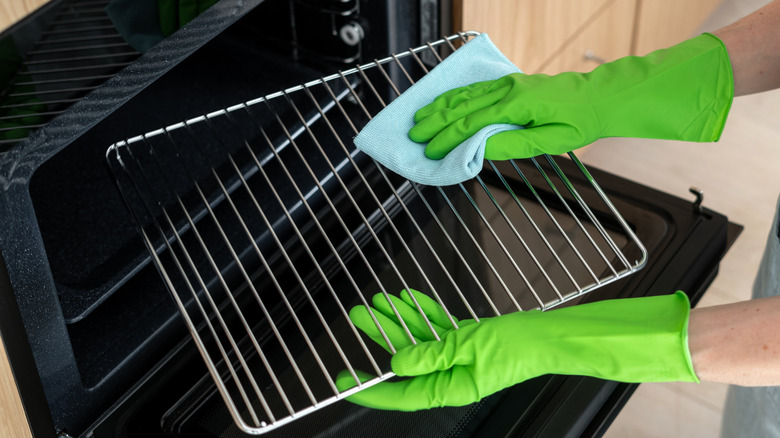How Long Does The Self-Cleaning Oven Feature Typically Take?
While some people – like Chef Paul Hollywood — enjoy cleaning their ovens, most people feel like this household chore is daunting. The task can require a lot of elbow grease, especially if you've put it off for a long time, but doing it can make your oven work more efficiently and extend its life span. Fortunately, using the self-cleaning feature takes a lot of the work out of the equation. But, how long does it take?
The answer depends on if you're doing a light self-clean (otherwise called a steam clean) or the full self-clean cycle. As the name suggests, the light self-clean feature on some ovens can take 30 to 90 minutes. It uses a typical baking temperature and the steam from water to loosen debris and grime so that you can easily wipe it away when the oven is cool enough to touch — just like if you were preheating your oven before cleaning it manually. This feature, though, is ideal for cleaning a minimal amount after small spills.
For cleaning bigger messes and caked-on food residue, a full self-clean cycle is in order and can take anywhere from 90 minutes to six hours depending on your oven model. It uses very high temperatures, ranging from 800 to 900 degrees Fahrenheit, to turn debris into ash that you can wipe away with ease. Because of the high heat, most ovens automatically lock the door during the cycle as a safety precaution.
The dos and don'ts of using the self-cleaning oven feature
Before you start, take all of the oven racks, bakeware, broiler pans, and any other loose items out, including any plastic pieces, oven liners, and foil. Then, remove loose debris from the interior walls to keep the smoke to a minimum. Keep in mind that smoke is normal because the purpose is to turn the leftovers into ash.
Another priority is cleaning the door window; any remaining grime may create stains during the self-cleaning process. Plus, make sure that your kitchen is well ventilated. Turn on the range hood's exhaust fan and open your windows, if possible. Any pets or children should be kept outdoors or in separate, closed rooms to protect them from any resulting smoke, odors, and fumes.
What you don't want to do during the self-cleaning cycle, though, is touch or open the oven, which is why most doors automatically lock. Additionally, you should never use a chemical cleaner before, during, or directly after because it can damage the appliance's protective coating.
When the cycle is done and the oven has cooled completely, you can safely wipe it out with a damp cloth or vacuum up loose debris. Don't forget to wash all of the accessories with hot, soapy water before you put them back inside, and it's a good time to clean and shine the knobs and the rest of the exterior, too.

